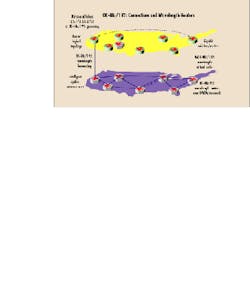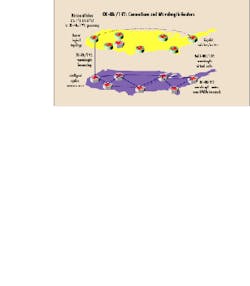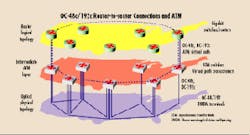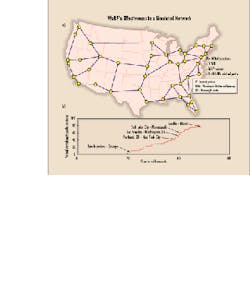Laying the foundation of the optical Internet
Laying the foundation of the optical Internet
An optimal optical networking architecture must integrate intelligence within the network, rather than lay it on top.
John C. Adler and Stevan Plote, Monterey Networks Inc.
The realization of the optical Internet requires great leaps in network scalability, latency, and survivability. The abundance of bandwidth afforded by dense wavelength-division multiplexing (DWDM) creates only a set of point-to-point optical pipes. Internetworking gigabit switch/routers around these pipes using Synchronous Optical Network/Synchronous Digital Hierarchy (SONET/ SDH) network elements is not feasible given that with OC-48c/192c Internet protocol (IP) routing, no time-division multiplexing (TDM) is necessary. Introducing Asynchronous Transfer Mode (ATM) switches or terabit routers as intermediaries where there are one or more OC-48c flows between backbone routers misapplies grooming devices for wavelength forwarding, while simultaneously increasing latency and requiring seconds and even minutes for restoration versus the 50 msec previously provided by SONET.
A new architecture, based on a device we will call the wavelength router, would achieve all three objectives by introducing "native" intelligence into the optical network. It would directly connect gigabit switch/routers across network-wide wavelength routes restorable in 50 msec without a SONET ring`s bandwidth penalty. By solving the wavelength junction connectivity problem, the wavelength router would go beyond the optical crossconnect to lay the foundation for the long-haul optical Internet core and enable the broad deployment of multi-gigabit services for wholesale, retail, and on-the-spot bandwidth markets.
Need for intelligence
As the amount of data carried by the Internet backbone has grown exponentially, and as voice and data traffic have begun to unite on the emerging optical Internet, network architects have recognized three significant challenges:
making the network grow to meet demand (scalability)
keeping the added demand from causing excessive network queuing delays (latency)
protecting against and recovering quickly from failures (survivability or restoration).
It is generally recognized that to deal with a growth rate of 1000% per year, the Internet must be scaled through the effective interconnection of the new generation of gigabit switches/routers. Adequate scaling of long-haul backbones will also involve optical transmission technologies like DWDM.
But as DWDM vendors continue to topple barriers to the number of wavelengths a fiber strand can carry, managing the abundant bandwidth DWDM affords is a growing challenge. Today, wavelength provisioning and traffic assignment is a largely manual process. Assignment of SONET systems to wavelengths is done through physical cabling, which offers little flexibility.
In contrast to the intelligent IP routing infrastructure in place today, the optical infrastructure thus far has emerged as a set of point-to-point pipes that does not incorporate the intelligence needed to scale and self-restore. So long as this situation remains, the emerging fiber-rich bandwidth brokers will be able to sell optical bandwidth only in the form of dark fiber or unmanaged wavelength bundles. And large Internet service providers hoping to offer ubiquitous multi-megabit IP-based network services over the optical infrastructure will be hard-pressed to scale their services without a far greater level of intelligence integrated into the optical network.
Two strategies are under consideration to achieve the objectives of network scalability, survivability, and reduced latency. These involve deploying intermediate network elements--either SONET add/drop multiplexers and crossconnects or ATM switches and virtual path crossconnects--between the gigabit switch/router and the point-to-point optical pipes. These solutions have drawbacks. But in each cases, intelligence is built on top of the optical network rather than integrated into it, making them ineffective as the network scales.
In contrast, the wavelength router architecture would integrate wavelength-routing intelligence--including network-wide wavelength provisioning and failed-route restoration capability--directly into the long-haul optical core. Wavelength routes between gigabit switch/routers would be rapidly restored without the use of intermediary devices. Wavelength routers would actually remove a layer of complexity from the network; along with gigabit switch/routers and the DWDM terminals, they would be the only network elements needed to build the optical Internet core.
Solution 1: SONET ADMs and crossconnects
Over the past decade SONET has become the transport medium of choice for service providers and has matured into a stable technology familiar to installation, maintenance, and operations personnel. Its ring architecture provides rapid (50-msec) restoration, easy access to lower-bandwidth circuits at intermediate network points, and circuit visibility.
But SONET`s main value has been its TDM capability, a technique in which information from multiple sources can be allocated bandwidth on a single wire based on a time-slot assignment. While TDM was a critical function in voice and leased-line networks where there are large numbers of lower-speed interfaces, it becomes superfluous when gigabit switch/routers are able to groom packets at the OC-48c and OC-192c levels.
Furthermore, the SONET ring architecture requires extensive use of repetitive equipment--and in the most common SONET implementations, service providers frequently double the number of SONET devices to extend full physical-line protection to all traffic. While SONET elements were once the consolidation point for many lower-speed circuits, accelerated network growth has positioned them as rapidly multiplying transmission elements that are difficult to manage and costly to deploy.
Solution 2:
ATM switches, virtual-path crossconnects
ATM has been widely accepted as a means to effectively engineer Internet traffic by establishing connections or virtual paths between routers. The ATM virtual paths make router networks easier to construct by giving the routers the appearance of being just a hop apart, where in reality the virtual path may traverse many intermediate ATM switches. The characteristics of each such virtual path can be controlled through ATM`s quality-of-service constructs, thereby optimizing the sharing of bandwidth. Furthermore, the physical routes that the virtual paths traverse can be tracked for performance-monitoring and traffic-engineering purposes. Additionally, ATM`s automated connection recovery establishes a stable link infrastructure between switches, presenting the routers with restorable circuits.
All this is about to change. As IP network cores continue to scale--as traffic between pairs of backbone routers reach just a single OC-48c/OC-192c volume--ATM`s virtual path becomes equivalent to a wavelength (see Fig. 1). So while the benefits of ATM`s fine virtual-path granularity, including quality of service, make it eminently suitable for access use, it becomes irrelevant in the optical core, where the appropriate switching granularity is the wavelength.
Finally, the effective management of these huge numbers of virtual paths depends on the widespread introduction of Private Network to Network Interface (PNNI), ATM`s dynamic virtual-path provisioning and restoration protocol. Even then, PNNI`s restoration times will be seconds or minutes, far inferior to the 50-msec benchmark set by the SONET ring. As a result, ATM switches and crossconnects offer no compelling value for inclusion as intermediaries in the optical Internet core.
Solution 3: Wavelength router architecture
The wavelength router aims to integrate intelligence directly into the optical network without introducing intermediate devices. In addition to many other benefits, this approach dramatically shortens the provisioning and restoration times that characterize non-native solutions.
The wavelength router interconnects backbone gigabit switches/routers directly through optical routes. With intermediate SONET and ATM eliminated, only the wavelength router and the gigabit switch/router are needed in the long-haul optical infrastructure with the DWDM terminals. The architectural division of labor between the two routers is straightforward and highly efficient. The gigabit router grooms packets from DS-1 (1.544 Mbits/sec), DS-3 (44.736 Mbits/sec), OC-3 (155 Mbits/sec), and OC-12 (622 Mbits/sec) flows to OC-48c or OC-192c streams. The wavelength router maps these streams to wavelengths, which replace ATM virtual paths for end-to-end transport across the network. As traffic increases, additional wavelengths are provisioned between appropriate router pairs performing traditional IP routing, tag switching, or MPLS (multi protocol label switching) (see Fig. 2).
Central to the wavelength router architecture is a distributed Wavelength Routing Protocol (WaRP), which provisions transcontinental virtual wavelength paths in seconds across many hops, restores them within 50 msec following physical failure, and prioritizes their restoration. Figure 3 shows a simulated use of WaRP on a realistic national backbone with restoration times ranging from 24 to 48 msec and with significant bandwidth savings over comparable ring topologies. WaRP is based on open routing protocols and standards established in packet and cell networks and is optimized to provide ultra-fast provisioning and restoration without the bandwidth penalties of SONET rings.
Role of the optical crossconnect
The advent of DWDM, and the resulting creation of huge numbers of wavelength-level junctions between traffic sources and destinations, has engendered a connectivity problem that, to date, has been handled via a cumbersome manual process. The optical crossconnect can solve the wavelength junction connectivity problem, but it alone cannot provide the needed intelligence to route and rapidly restore wavelengths end-to-end across the network.
This intelligence is best added through integral native wavelength-routing capability. Given that the wavelength router requires a switching core, which may be optical, electronic, or a hybrid, an optical crossconnect can serve as a key subsystem--the switching core--within the wavelength router, making advances in optical switching technologies highly synergistic with the wavelength router.
Architects of the intelligent optical Internet
The intelligent optical Internet will be built by Internet backbone providers and bandwidth providers or "brokers." IP backbone providers can flexibly aggregate gigabit switches/routers at IP terabit points of presence (PoPs) using wavelength routers while simultaneously interconnecting these "tera-PoPs" with optical bandwidth services available internally or through wholesale carriers. Bandwidth service providers can deploy wavelength routers at their backbone sites to optimize backbone bandwidth use and restore links upon failure. Regardless of traffic type, the wavelength router connects to OC-48 and OC-192 sources such as gigabit switches/ routers, ATM switches, and the installed base of SONET terminals that aggregate lower-speed voice, IP, and ATM leased-line traffic. It also connects to other wavelength routers to create the optical foundation that allows flexible assignment and end-to-end restoration of the wavelength paths. No longer dependent on the reliability and restoration capabilities of their facilities providers, Internet engineers can manage their physical infrastructure and optimize the technology for Internet network designs and architectures.
Bandwidth brokers can transition from today`s dark fiber sales and leapfrog wavelength services to create new bandwidth denominations--differentiated OC-48/192 wholesale, retail, and on-the-spot markets for ubiquitous multigigabit bandwidth. The wavelength router provides an integrated platform for building and controlling large transmission infrastructures for both long-distance and local providers. It gives service providers the flexibility to quickly adapt to the fast-changing requirements of the transmission infrastructure and meet the growing demand for multigigabit services to build new private and public networks. q
John C. Adler is director of product management and Stevan Plote is senior product manager at Monterey Networks, Inc. (Richardson, TX), www.montereynets.comFig. 3. Simulations have shown the effectiveness of the Wavelength Routing Protocol (WaRP). The simulated network (a) comprised 39 major WDM junctions, hundreds of wavelengths per junction, and hundreds of virtual paths end-to-end across the network. WaRP restoration times (b) ranged from 24 to 48 msec for long routes and lower for shorter routes while yielding significant bandwidth savings over comparable ring topologies.



